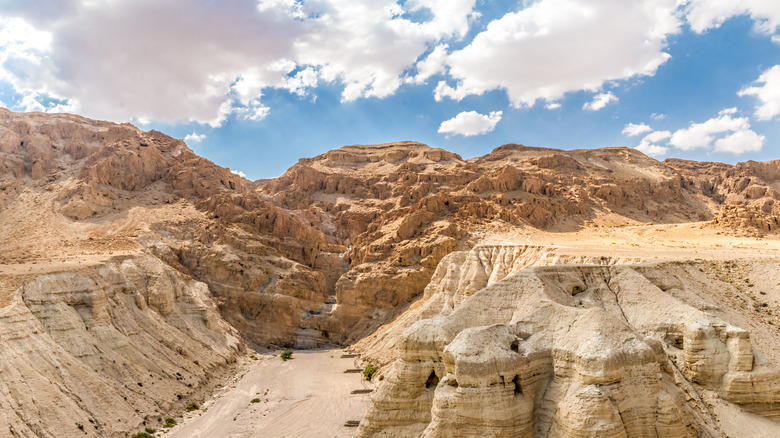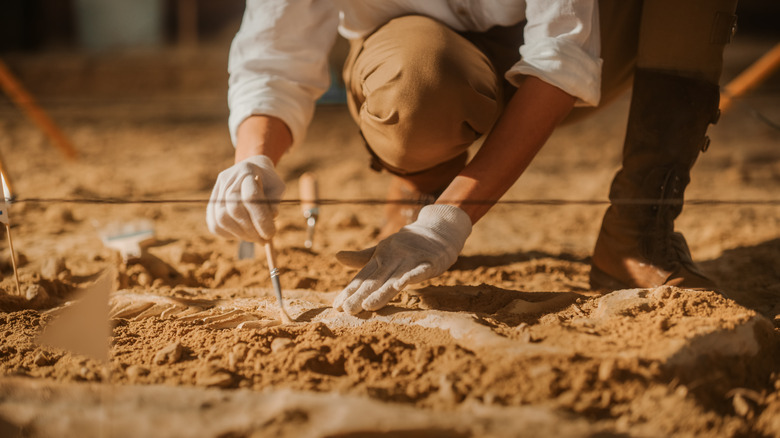Israel's Cave Of Horror Got Its Name Thanks To A Gruesome Discovery
Cue the long-bearded, raspy wise man voice: There is a cave, you see. A cave of mystery, secrets of the past, and artifacts of yore. It is in a great desert, deep underground, and contains sights the likes of which the world has never seen ... And also lots of little bits of one particular, like, really old scroll thing. Seek the cave!
Well, that's enough for an "Indiana Jones," "Tomb Raider," and perhaps "Uncharted" film, video game, spin-off, what have you. But more than fiction, such a cave does indeed exist in the Judean Desert, west of the Dead Sea in modern-day Israel; more than one cave, in fact. This region of the world — extremely arid, hot, and good for preserving parchments and other things — is where archaeologists found the famed Dead Sea Scrolls back in 1947 in the ancient Jewish community of Qumran (per Smithsonian Magazine). The Dead Sea Scrolls date to about 200 BCE, but the area has been used for storage all the way back to 10,500 BCE (via the BBC). We're talking a ten-millennia old basket, followed by a six-millennia old mummified skeleton, followed by lots of coins, parchments, and plenty of other things across a wide variety of caves, valleys, hollowed-out mountain recesses, you name it.
None of those items are particularly horrifying. One set of discoveries in the 1960s, though, led researchers to dub a particular cave the "Cave of Horrors." This cave, unlike others, held a full 40 skeletons.
An ancient desert refuge
To be fair, skeletons are a pretty common thing, and maybe not gruesome enough to warrant the title "Cave of Horrors." After all, lots of people have lived and died. Go back far enough, and you might be sitting on the spot where some dude tripped and broke his neck like 4,000 years ago. However, there's a key fact about the skeletons in the Cave of Horrors that make the whole thing horrific: the people were hiding when they died.
As The Conversation describes, the Cave of Horrors was a refuge for Jews fleeing from the Romans in the middle of a short-lived revolt (132 to 135 CE) during the reign of Emperor Hadrian. At the time, the Jewish kingdom of Judea had fallen under Roman rule and would remain so until 313 CE, as the Jewish Virtual Library explains. The Judean Desert must have proven an excellent spot not just for preserving artifacts, but lives too, because that wasn't the first time Jews had hidden there. A much more serious revolt from 66 to 70 CE left Jews fleeing to the very same region for the very same reason, as PBS outlines. This is the exact revolt that led to the Dead Sea Scrolls being spirited away to their final hiding spot, where they were found in 1947, as History says.
And the Jews in the Cave of Horrors? Evidence indicates that the Romans set up camp outside and waited while those inside died of starvation.
A new discovery kept safe from looters
Admittedly, it's pretty horrific to imagine a group of Jew hiding from soldiers and trying to keep quiet while their executioners wait nearby, almost like an unsettling vision of future, World War II Nazi Germany. It's even worse to imagine those hiding never leaving, but simply dying where they huddled. But indeed, this looks like it's exactly what happened, as The Conversation explains. Those inside the Cave of Horrors — including children — didn't suffer from any physical wounds, which suggests they either died from starvation or dehydration or smoke inhalation from a fire they built inside the cave.
These victims took with them their most prized possessions and buried them inside the cave. This included, amongst other things, religious documents that have been discovered to contain some of the earliest versions of the Biblical books of Zechariah and Nahum, specifically Zechariah 8:16–17 and Nahum 1:5–6. This is only what researchers have uncovered so far, though, as this is a recent, 2021 discovery.
The Cave of Horrors was first found in 1953, but not excavated until 1961. Fear of the cave's contents being pilfered by thieves led the Israel Antiquities Authority (IAA) to head back and dig deeper into the complex, which spans eight caves total and rests at the bottom of an 80-meter, or about 87 yards, drop accessible only by rope. Yet lo and behold, it looks like looters once got within 10 centimeters of the newly rescued artifacts (via Vintage News).


